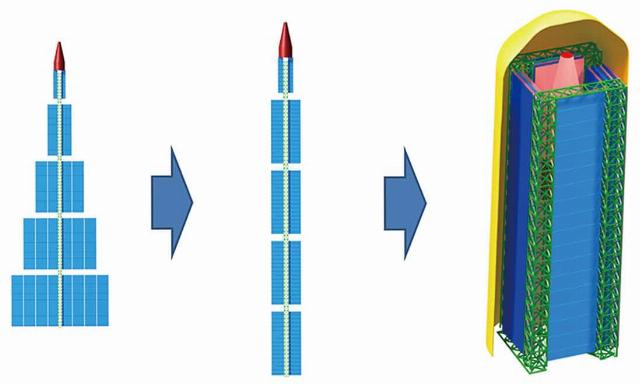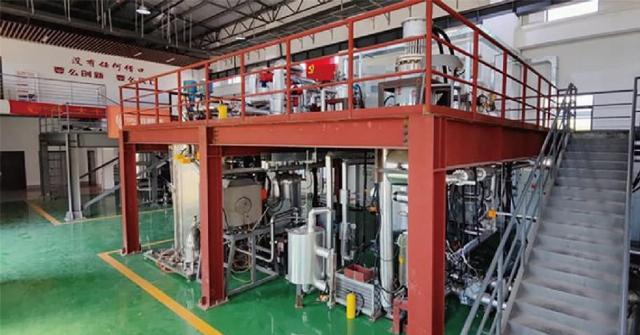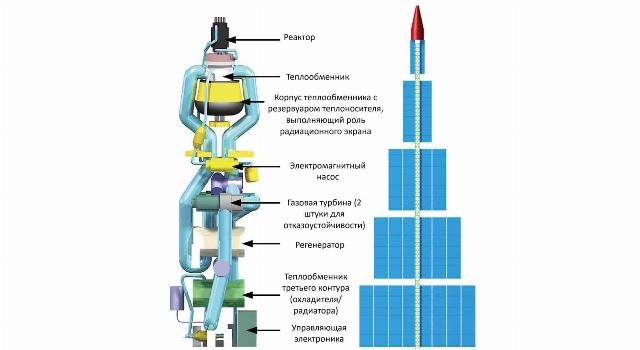Chinese scientists have assessed their capabilities to implement the project of a promising space nuclear reactor with an electric capacity of one and a half megawatts. This is an installation with a liquid metal coolant and a gas turbine, which by weight and dimensions fits on a medium-class launch vehicle. Several prototypes of its critical components have already passed successful ground tests. But many of the necessary technologies require either international participation or intensive funding to refine.
Ambitious projects for the exploration of other planets and deep space are still at the stage of preliminary study facing the huge problem of their large energy needs. Solar panels are good, reliable and time-tested, but their specific power is low. The International Space Station carries 2.5 thousand square meters of solar panels, which produce an average of only 120 kilowatts of electricity. It is enough for the work of the orbital laboratory, but there can be no talk of any highly efficient electric propulsion systems.
There are virtually no alternatives to nuclear reactors for relatively fast manned flights to other planets, and even more so to the outskirts of the Solar System. Therefore, Chinese nuclear physicists are working on promising installations capable of ensuring the competitiveness of their native nation in the new space race. This is a very difficult and expensive task, the progress of which can be traced back to a recent publication in the peer-reviewed journal Scientia Sinica Technologica. Its authors are employees of a dozen and a half leading scientific organizations in China.
The article discusses the design of a nuclear reactor with a liquid metal coolant, a gas turbine and a cooling system based on heat pipes. Lithium acts as the coolant of the first circuit, and the helium—xenon mixture acts as the coolant of the second circuit. The heat pipes of the cooler are filled with an alloy of potassium and mercury. The estimated thermal power is six megawatts, electric power is up to one and a half megawatts net, another 50 kilowatts are spent on the internal needs of the reactor (pumps, heaters, control system).
In the section of the publication with a preliminary analysis of existing developments in the field of similar installations, the authors explained why they chose this particular scheme. In short, it is optimal in terms of the ratio of specific power, reliability and mass for the selected tasks and the power range. Gas-phase reactors are simpler (the primary coolant can be directly directed to a gas turbine), but require heavier shielding, and their operating temperatures are higher. Liquid metal reactors with heat pipes in the primary heat exchange circuit promise higher resistance to potential failures due to the simplicity of the design, however, the specific power of such an installation will be significantly less.

With a mass of just under eight tons, the promising Chinese space nuclear power plant fits folded under a fairing with a height of 12 meters and a diameter of 4.4 meters — this is a lot, but even medium-class launch vehicles can do it. A reactor with a decomposed radiator is shown on the left
Image source: YiCan Wu et al., Scientia Sinica Technologica
Chinese scientists are conducting a similar analysis of all the other main nodes of a promising power plant. The most interesting choice of primary coolant is not potassium or sodium, which are common for liquid metal reactors, but lithium. Its specific heat capacity is several times higher, in addition, it remains liquid up to a temperature of 1615 degrees. And the higher the temperature of the hot part of the heat engine, the higher its efficiency, all other things being equal.
There is only one problem: no one has made such reactors yet, there are some developments in the USA and Japan, but they have not gone beyond the laboratories. Consequently, specialists from the People's Republic of China will have to solve many difficult tasks in the field of materials science.
A large part of the article by Chinese scientists is devoted to potential difficulties in development. Among them:
- development of a vanadium-rhenium alloy and technology for manufacturing a metal composite from it for primary circuit pipelines (as well as methods for processing and welding such materials);
- testing and fine-tuning of a separator for separating helium from lithium (it is produced by irradiation) in the first circuit, which should work in zero gravity (previously they were tested only on Earth);
- creation of materials for the blades of a gas turbine, which will have to work continuously at a temperature of 1,500 degrees for decades;
- development of technologies for the manufacture of carbon-carbon composites for the main radiator of the cooling system (in the sheets of which heat pipes will be enclosed);
- development of uranium-nitride ceramic nuclear fuel.
Chinese scientists have placed special emphasis on the fact that these, as well as many other missing knowledge and technologies, have been developed abroad to one degree or another. The authors of the article identified several areas of work for national research institutions that require increased attention and funding. Only then, according to the researchers, by 2035-2050, when such a space reactor is needed, China will have it. Otherwise, the country risks falling behind other participants in the space race of the XXI century.

Photo of a prototype of a part of the units of a promising space nuclear power plant
Image source: YiCan Wu et al., Scientia Sinica Technologica
A considerable part of the required technologies is already being worked out. For example, recently (when exactly is not reported), a prototype heat exchanger between the first and second circuits of the future reactor passed ground tests. In the test, it was possible to test a corrosion-resistant pipeline for a lithium coolant, an electromagnetic pump and a helium-xenon turbine. Proof of the concept's operability has been obtained, further improvements are required, which are necessary for the full operation of the installation for a long time.

